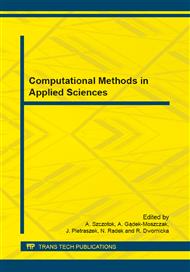p.55
p.63
p.69
p.75
p.81
p.87
p.93
p.101
p.107
Analysis of Structure of Elements for Automotive Industry
Abstract:
The paper presents the results of the structure and chemical composition of materials used to manufacture of gear wheel for the automotive industry. Analyzed gear wheel that is a part of one of the mechanical systems of an automotive vehicle was made of sinter Sint-D 32 in the technology of powder metallurgy and alloy structural steel for quenching and tempering 42CrMo4. The cause of the analysis was to research for an alternative material for sinter Sint-D 32 after identified low static strength according to the requirements applicable in the automotive industry. For the analysis were used standard test methods applicable in materials science. Based on microstructure and mechanical properties analysis performed according to requirements applicable in the automotive industry, the research found that steel 42CrMo4 is relevant material to be used in serial production for this particular gear wheel.
Info:
Periodical:
Pages:
81-86
Citation:
Online since:
January 2015
Authors:
Keywords:
Price:
Сopyright:
© 2015 Trans Tech Publications Ltd. All Rights Reserved
Share:
Citation:


